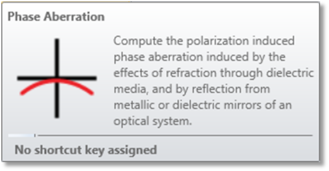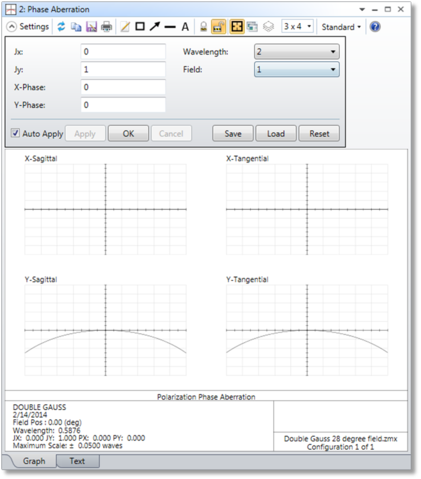Phase Aberration


Computes the polarization induced phase aberration of an optical system.

Jx, Jy Jones electric field. See " Defining the Initial Polarization "
X, Y Phase Phase of the X, Y component of the Jones electric field in degrees.
Wavelength The wavelength number of the rays to trace.
Field The field position number of the rays to trace.
Discussion
Polarization phase aberrations are induced by the effects of refraction through dielectric media, and by reflection from metallic or dielectric mirrors. This feature computes for the specified field position and wavelength the polarization phase aberration in the image space for the X and Y orientations of the electric field vector as a function of entrance pupil coordinate. The aberration is defined as the variation in the phase of the electric field in one direction, such as X or Y, as a function of the pupil position. For example, if the electric field in the X direction is (0.7 + 0.7i) for the chief ray (note the E field values are complex), and at some other point in the pupil the electric field in the X direction is (-0.7 + 0.7i) then the polarization phase aberration between these points is one-quarter wave (the phase of Ex changed from 45 degrees to 135 degrees, or one-quarter wave). Note this is completely distinct from the phase differences between the Ex and Ey fields, which describe the polarization state (linear or circular for example). For phase differences between Ex and Ey see " Power Pupil Map ".
Like the usual OPD plots, the polarization phase aberration is referenced to the chief ray. However, there are cases where the chief ray phase cannot be determined in both orientations. For example, in an axial symmetric system, if the incident polarization is linear in the Y direction, there is zero intensity in the X direction for the chief ray, and therefore the X phase is indeterminate. For other rays in the pupil, there is generally a slight rotation of the polarization, and therefore the resulting electric field in the X direction yields a valid phase angle. To avoid this discontinuity in the phase, OpticStudio averages two rays on either side of the chief ray to interpolate the chief ray phase. The problem may still appear under certain circumstances, even with this averaging technique. In all cases, the phase data is still valid, because the phase aberration has no effect on image quality if the intensity is zero.
Next:


